If you are looking for the best exercise to build stronger arms? Bench dips may be your answer.
Bench dips are a simple exercise that can be done almost anywhere and have many variations to match your fitness level. Use it as part of a strength workout for your upper body.
The tricep bench dip is a bodyweight triceps exercise that you can also overload by placing weight plates over the legs, making it a useful exercise for individuals of varying strengths and experience levels.
When performed with strict form, the bench dip is an effective exercise to build your triceps (the back part of your arms), even if using bodyweight alone. It will also target the shoulders (particularly the anterior delt heads), chest (pectorals), and serratus anterior.
In this article, you will learn everything you need to know about:
- Tricep Muscles
- How to perform the bench dips correctly.
- You will also learn its benefits,
- How to avoid common mistakes
- What are the best variations of bench dips and how to do them.
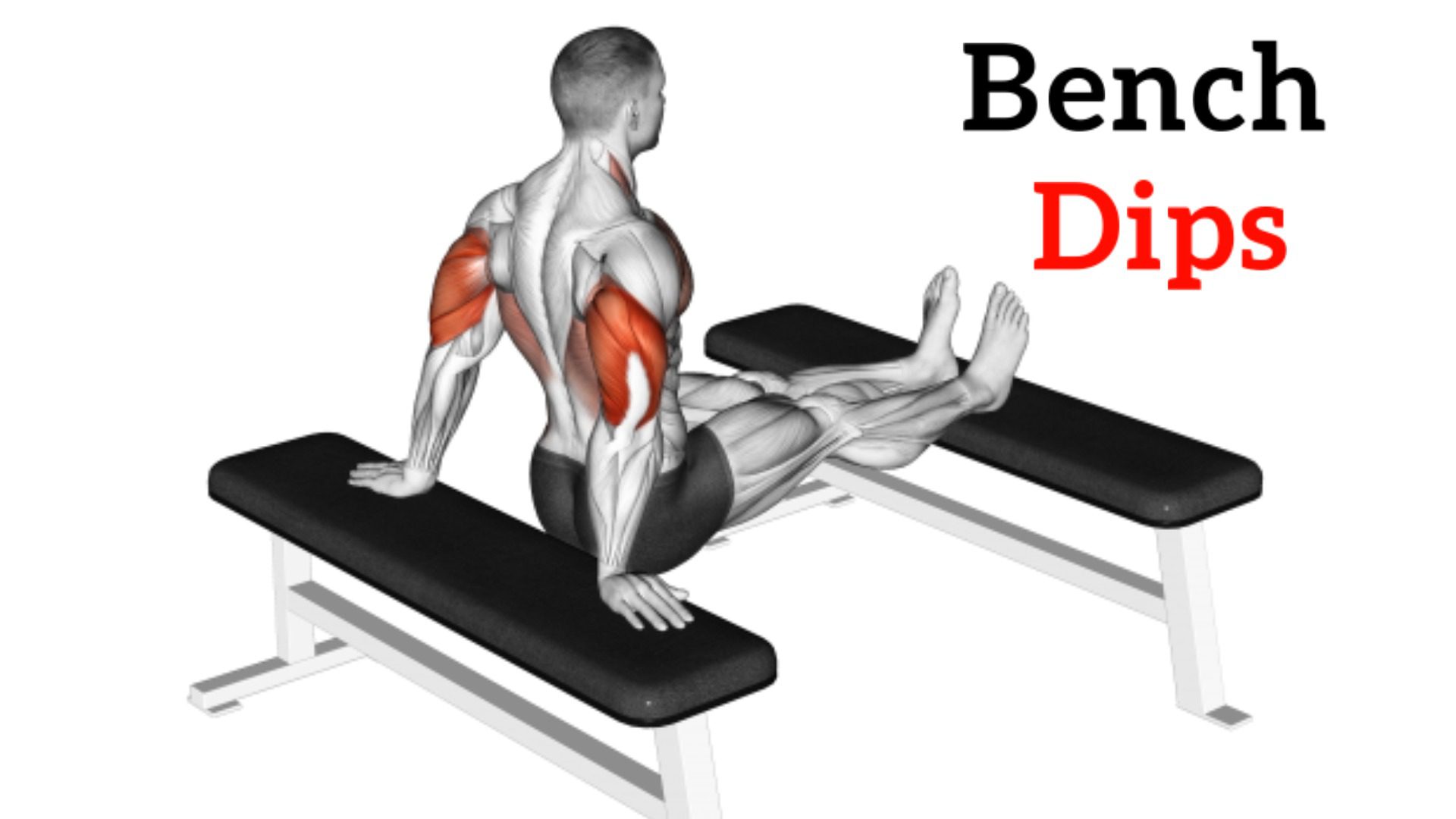
- Triceps Brachii Muscle (Anatomy)
- What Is Bench Dips
- Benefits Of Bench Dip Tricep Exercise
- Muscles Worked During Bench Dip
- How To Do Tricep Bench Dip
- Avoid This Common Mistakes While Doing Bench Dips
- 1. Not doing complete reps
- 2. Flaring Elbows out
- 3. Leaning too far forward
- 4. Going too Low
- 5. Locking Elbows
- 6. Doing Reps too Quick
- 7. Start Lifting Heavy
- Bench Dip Variations (Make It Easier Or Harder)
- 1. Knee Bent Bench Dip
- 2. Bench Dip With Straight Legs
- 3. Weighted Bench Dip
- 4. One-arm bench dip
- Parallel Bar Dip v/s Bench Dip
- Parallel Bar Tricep Dip
- How to Do Parallel Bar Tricep Dip
- Muscles Worked During Bars Dips
- How To Do Parallel Bar Triceps Dip
- Tips
- Sets, Reps and Frequency for Bench Dip
- Sets and Reps:
- Frequency:
- FAQ
- Do dips work all 3 heads?
- Can I do bench dips everyday?
- Are dips better than push-ups?
- How can you add this In routine?
- Does bench dips work lower chest
- How Many sets and Reps?
- Safety and Precautions
- Takeaways
- Know More about Tricep Training
- Best Bodyweight Triceps Workout You Can Do at Home
Triceps Brachii Muscle (Anatomy)
When we know about the anatomy of the triceps, then we can easily and effective train with bench dip.
Triceps, formally called triceps brachii (Latin for “three-headed muscle of the arm”), are the large muscles at the back of the upper arm behind your biceps.
The muscles of the Triceps are opposite of the biceps, responsible for 2/3 of upper arm mass. It’s important to focus on it and work on the three muscles in the tricep head to get the most results.
- Long head: The largest part of the tricep that runs along the back of the upper arm.
- Lateral head: The smallest of the three muscles that is located on the outside of the arm.
- Medial head: Located right around the middle of the upper arm.
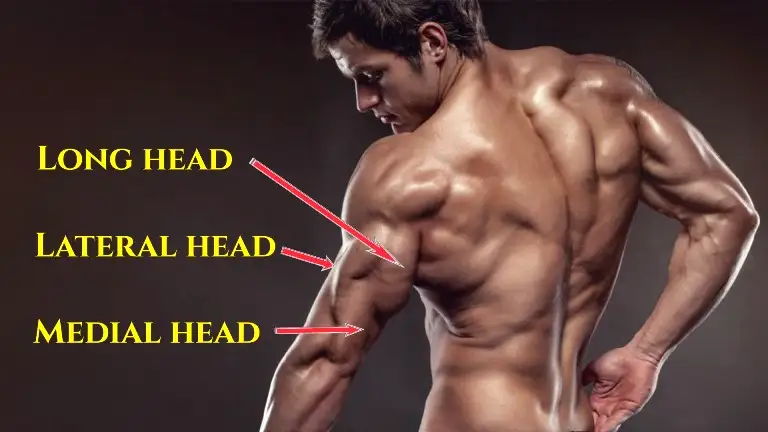
What Is Bench Dips
The bench dip is one of the most fundamental, best exercises to build triceps strength and bigger arms. The bench dip only requires a bench, or any other sturdy surface that you can find at the time.
The dip is an excellent triceps exercise for beginners if done properly, as both arms are supporting the bodyweight, giving you greater control of the movement.
The bench dip is different from the regular dip.
- The traditional method of dips involves elevating oneself and grasping two bars, thereby mimicking the movement of pressing.
- The bench dip is a simpler exercise than the normal dip that you can do without having to get your feet off the floor. When performing a bench dip, you’ll use just that, a bench.
Benefits Of Bench Dip Tricep Exercise
Bench dips are easy to learn and perfect in no time at all. They do not require a lot of focus on form, and are not hard enough to be done by only experienced people.
- Dips strengthen the muscles in your chest, shoulders, triceps.
- When done correctly, bench dips can add muscle mass to your upper body. This exercise can also help build your strength for other exercises like bench presses.
- Dips are an excellent exercise to increase flexibility in the shoulders and wrists, as well as gaining muscle mass in the upper body.
- Bench dips require a great deal of core muscle activation. This helps you to be balanced, stable and coordinated.
- In addition, it’s an exercise that uses plenty of stabilizing muscles, which will result in a more developed upper body. With stronger joints and developed stabilizing muscles, you will be less susceptible to injury when doing other exercises.
- Bench dips are the best exercises that you can do at home and Gym. These exercises can be done with items like stairs, chairs, or other sturdy raised surfaces.
- It works all the 3 heads of triceps muscles, including the lateral head, long head, and medial head.
- The bench dip is a versatile exercise that can be done anywhere using your available resources.
- Strong triceps help with shoulder stability and improve your range of motion.
- Triceps main responsibilities are extending the elbow joint or simply straightening the arm.
Muscles Worked During Bench Dip
- Bench dips primarily target the triceps muscles.
- In addition to the triceps, bench dips also engage the anterior deltoids (front shoulders) and pectoralis major (chest muscles) as stabilizers.
- Also, bench dips work the rhomboids and trapezius muscles in the upper back to keep the shoulder blades stable.
How To Do Tricep Bench Dip
The bench dip with elevated legs exercise is one of the basic and best workouts for building the triceps and bigger arms. The feet-elevated bench dip is a popular bodyweight exercise for building the triceps, chest, and shoulders.
Elevating the feet brings more chest and shoulder into the movement. It also allows for extra weight on the hips.

- Place your hands on the side of a flat bench so that your body is perpendicular to the bench.
- Sit on one bench and place your feet on the edge of the other bench so that your legs are suspended between the two.
- Your arms should be fully extended with your palms on the bench.
- Bend your elbows to lower your body down until your elbows reach 90 degrees.
- Now extend your arms to lift your body back to the starting position, flexing your triceps hard at the top.
Avoid This Common Mistakes While Doing Bench Dips
The bench dip needs to be done perfectly to activate the necessary muscle groups. This exercise will get you the most out of it if you avoid the common mistakes.
1. Not doing complete reps
Completing partial reps instead of a full rep won’t fully engage the triceps, negating some benefits of the exercise. Make sure you lower down until your upper arm is parallel to the ground and your elbow forms a 90-degree angle.
2. Flaring Elbows out
When you let your elbows flare out, you move the tension from your triceps to your shoulders, which can cause injury. Ensure that your elbows stay tucked into your body throughout the dip.
3. Leaning too far forward
Take care that you are always using proper form by keeping your chest high and open, and head looking straight ahead, making sure to avoid rounding the front of your shoulders or hunching forward with each movement.
It is important that you start in an upright position. Leaning forward will focus on your chest and shoulder muscles and not your triceps.
4. Going too Low
If you go too low in the dip, you’ll put too much pressure on your shoulder. Stop when your upper arms are parallel to the floor and rise back up.
Stop at the 90-degree elbow angle mark that makes your arms parallel to the floor. This would help you use your movements to the fullest.
5. Locking Elbows
You shouldn’t lock your elbow at the top of the movement. Keeping them slightly soft maintains tension on the triceps.
6. Doing Reps too Quick
If you rely on momentum to complete each rep, you miss out on some of the move’s many benefits. Move slowly and with control for maximum results.
7. Start Lifting Heavy
You should only do weighted bench dips after you’ve mastered your bodyweight bench dips and can do them in a controlled manner. Never compromise form to lift more weight. It’s safer and more sensible to build up gradually.
You may be pleasantly surprised by the results if you make your form more strict and tighter.
Bench Dip Variations (Make It Easier Or Harder)
Modification of the bench dip can increase or decrease the intensity of muscle response. Changing the leg positions and adding weights to your routine will make a big difference in how the muscles respond.
If you want to make bench dips easier, then do them with Knees Bent. It is easier if you bend your knees and put them on the floor.
The next level up in difficulty is to extend the legs out straight with the heels on the floor. If you straighten your legs and put your feet farther away from you (heels on the floor), it will be a bit harder. This version is easy to do because you’re not lifting a lot of your bodyweight, and it doesn’t require a lot of flexibility.
To make bench dips harder, you can increase the number of sets and the number of times you do them. Or doing a single-arm bench dip. When bench dips with your feet up get too easy, you can have a workout partner put a weight plate on your thigh to make it harder.
1. Knee Bent Bench Dip
The bent knee bench dip is easier than the standard bodyweight dip because you don’t need the same amount of physical strength. Knee bent bench dip is a medium-intensity exercise that uses your own body weight to strengthen your triceps.
It hits all three heads of the triceps (Long, medial, short) which is very important for developing maximum size and strength gains.
Bench dips are easy to learn and can be done almost anywhere, so they’re a great home exercise for a beginner.
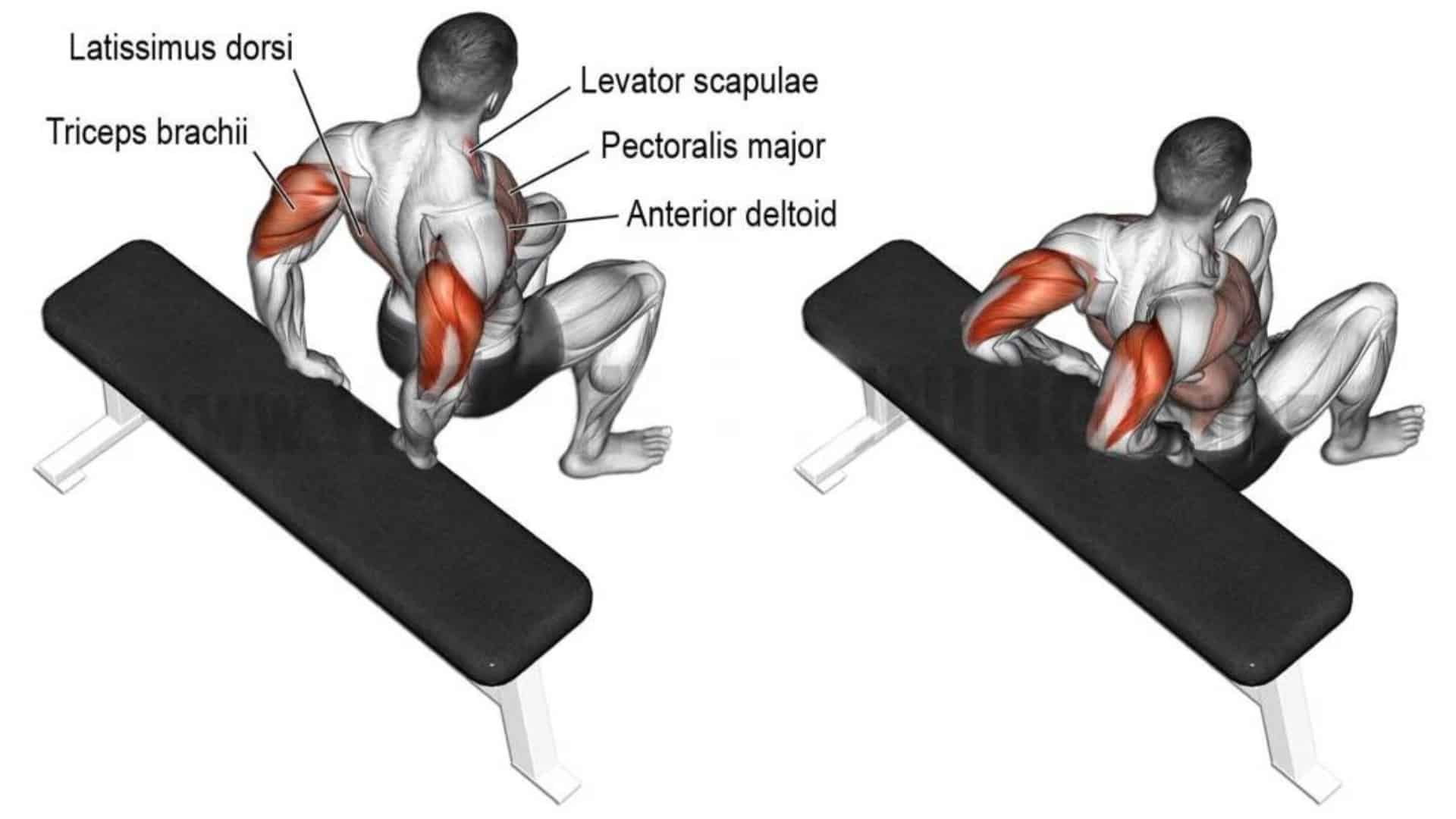
How To Do Knee Bent Bench Dip
- Place your hands on the side of a flat bench so that your body is perpendicular to the bench when you place your feet out in front of you.
- Only your heels should be on the floor, and your legs should be straight. Keep your knees and hips bent.
- Your arms should be fully extended with just your palms on the bench.
- Bend your elbows to lower your body down until your elbows reach 90 degrees.
- Now extend your arms to lift your body back to the starting position, flexing your triceps hard at the top.
Read More: Long Head Triceps Exercises For Bigger, Stronger Arms
2. Bench Dip With Straight Legs
Tricep bench dip with straight legs is a simpler version of the standard bench dip that you can use to build your arms at home, at the gym, or even on a park bench while you’re running in the morning.
While still a beginner-friendly move, this variation is slightly tougher because you have to lift and lower a higher proportion of your own bodyweight.
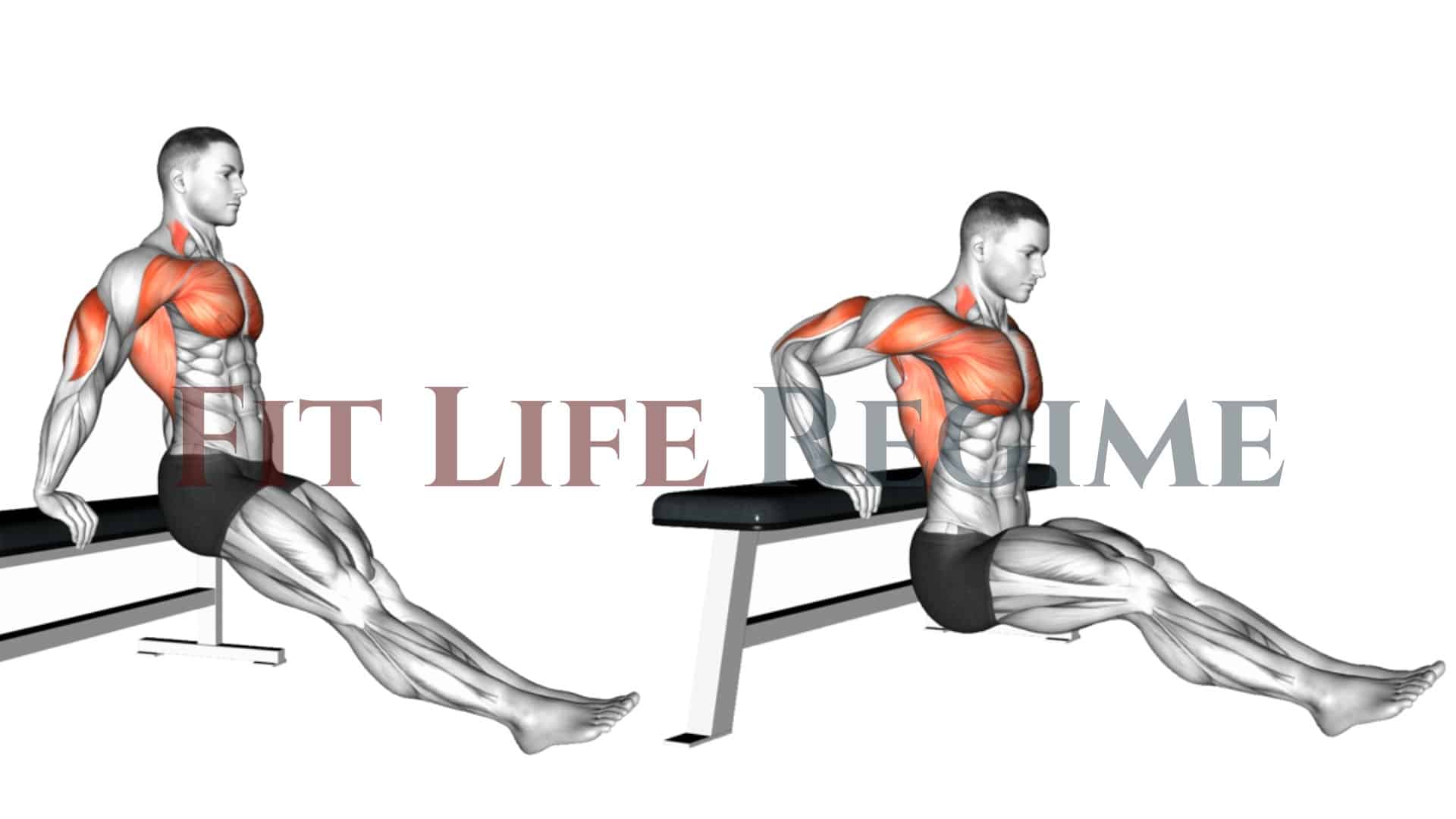
How To Do Bench Dip With Straight Legs
- Position your hands shoulder-width apart on a secured bench or stable chair.
- Slide your butt off the front of the bench with your legs extended out in front of you.
- Your arms should be fully extended with just your palms on the bench.
- Bend your elbows to lower your body down until your elbows reach 90 degrees.
- Now extend your arms to lift your body back to the starting position, flexing your triceps hard at the top.
3. Weighted Bench Dip
Weighted bench dip is a great exercise for building the triceps muscles, the lower chest area and the front heads of the shoulders.
The use of a barbell plate will add resistance and make this exercise more difficult, which will require you to balance and stabilizer your upper body.
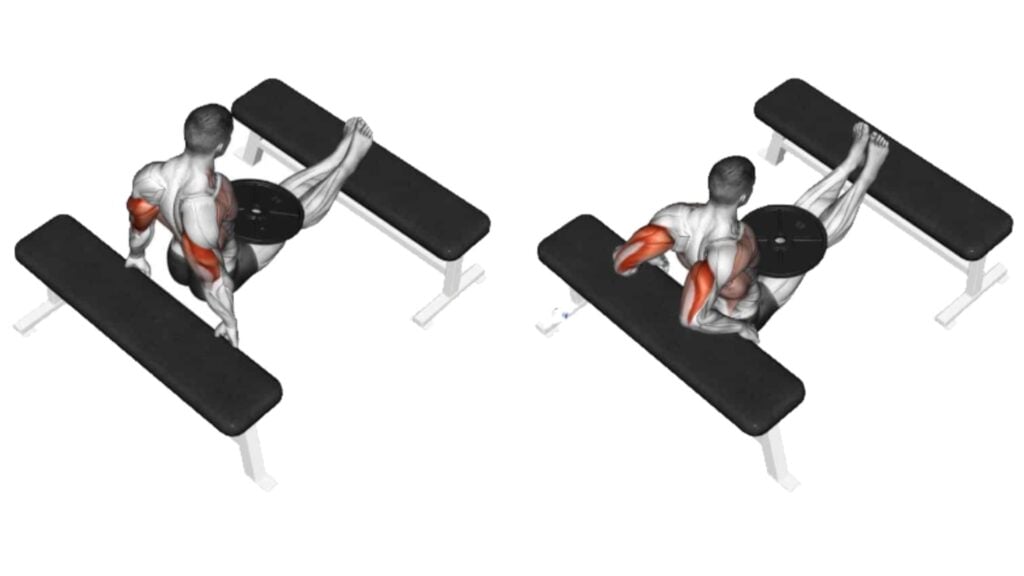
How To Do Weighted Bench Dip
- Place your hands on the edge of a bench and extend your legs in front of you, resting your feet on another bench
- Have a training partner place a weight plate on your thighs.
- Keeping your body close to the bench, bend your elbows and lower your butt, stopping when your upper arms are parallel to the floor.
- Slowly push back up while squeezing your triceps. Do not lock the elbows out at the top of the exercise.
- Do 8–12 reps and then have your partner take a plate off, so you can keep going.
4. One-arm bench dip
The one-arm bench dip is a challenging and very effective movement that primarily targets your triceps, but your glutes and quads also get worked secondarily.
However, this is not a beginner’s exercise or for someone who does not have adequate upper body strength. For an easier variation, you can do a bench dip.
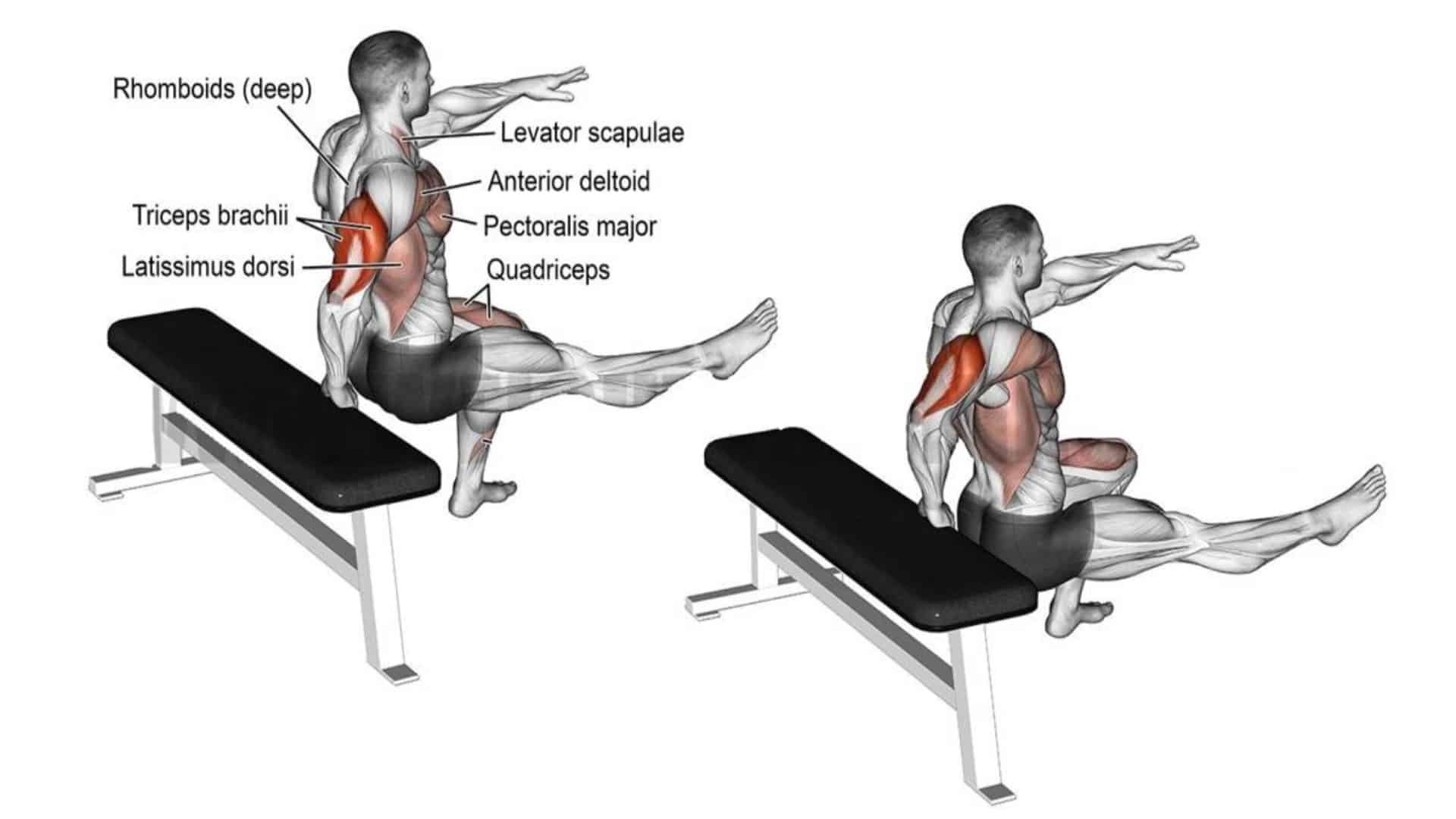
How To Do One Arm Bench Dip
- Place your hands (palms) on the side of a flat bench with your back straight, knees bent, and feet flat on the floor.
- Slide your buttocks off the bench. Raise your left arm and right leg straight out in front of you.
- Your bodyweight should be being supported by your right arm and left leg.
- Inhale as you flex your elbow to lower your body until you feel a mild stretch in your shoulder.
- Exhale as you extend your elbow to push your body back up to the starting position. Feel the tricep by squeezing the tricep.
- Repeat for the desired number of repetitions and repeat the exercise with your left arm.
Parallel Bar Dip v/s Bench Dip
In a gym, you can do parallel bar tricep dips where you are supporting the entire body over a parallel bar, but you can also do it on a bench or chair.
In the conventional dip, you would lift the entire bodyweight on two parallel bars to perform the movement. When performing a bench dip, you’ll use just that, a bench. This exercise is usually performed using just one or two benches or wide, firm chairs.
However, if you want to increase the resistance and difficulty level, you can use another bench or chair to raise your legs.
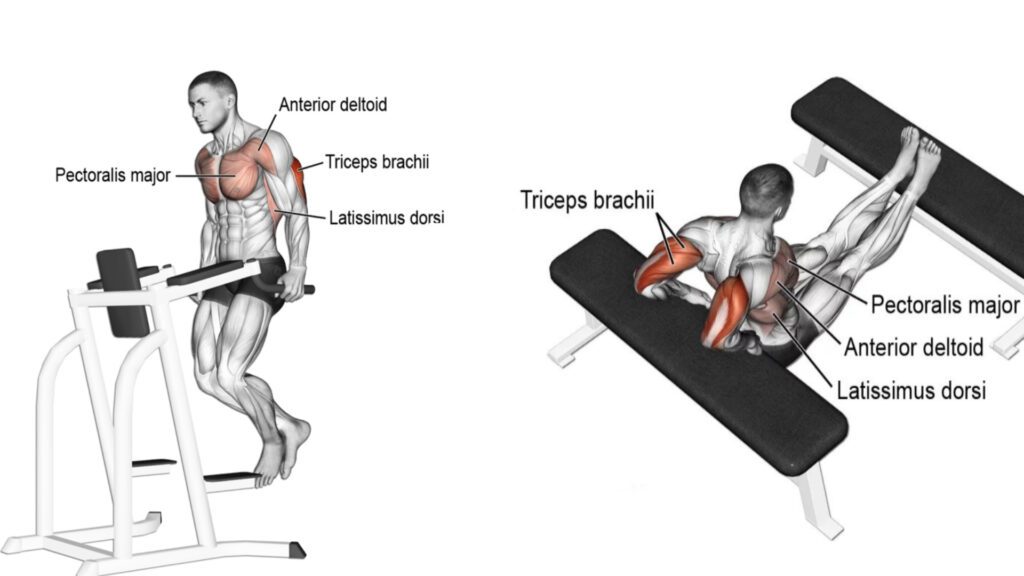
Parallel Bar Tricep Dip
Parallel bar dips enable you to utilize your entire bodyweight, thus providing higher resistance and a better workout.
How do you position your body vertically when doing parallel bar dips? It can either emphasize working out your pecs or your triceps.
- To focus more on your chest muscles, you have to lean your torso slightly forward while doing the set.
- On the other hand, to target your triceps, you have to keep your body vertically straight throughout the whole sequence.
A regular dip is a progression of a bench dip, as it requires much more strength to complete.
How to Do Parallel Bar Tricep Dip
Parallel bar triceps dip is one of the most effective compound movements for the upper body, especially pushing muscles in the chest and triceps.
When performed on narrow parallel bars with elbows back and your torso upright, the dip becomes one of the best exercises for building triceps mass.
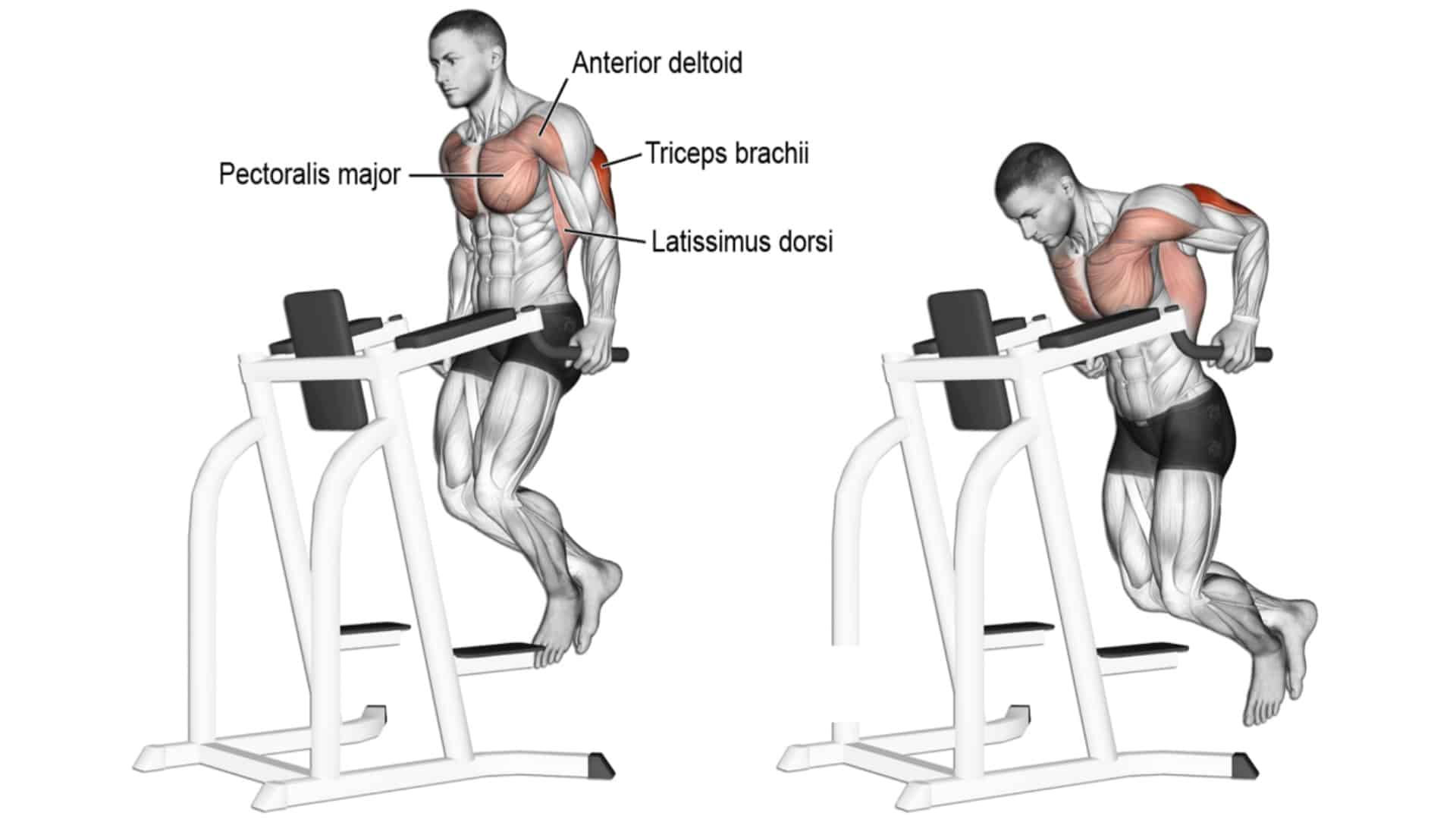
Muscles Worked During Bars Dips
Primary: Triceps.
Secondary: Anterior Deltoid, Pectoralis Major, Latissimus Dorsi, Pectoralis Minor, Rhomboids.
How To Do Parallel Bar Triceps Dip
- Grasp the dip bars with your arms extended and locked.
- Keep your body as vertical as possible to keep the emphasis on the triceps and away from the chest.
- Keep your elbows as close to your sides as possible as you bend them to lower your body down until your upper arms are about parallel to the floor.
- Press your hands forcefully into the bars to extend your arms and raise your body back up.
- Repeat for the recommended number of repetitions.
Tips
- Do not lock out your elbows at the top of the movement.
- To focus effort on the triceps, keep your body upright and elbows tucked in.
Sets, Reps and Frequency for Bench Dip
It’s important to customize bench dip sets, reps, and frequency based on your fitness goals, current strength level, and overall workout routine.
The specific numbers may vary, but here are some general guidelines to help you.
Sets and Reps:
- Beginners: Start with 2 to 3 sets of 8 to 12 reps per set.
- Intermediate: Progress to 3 to 4 sets of 10 to 15 reps per set as you build strength and endurance.
- Advanced: 4 to 5 sets of 12 to 15 reps per set. You can also incorporate more challenging variations or add weight to increase the intensity.
Frequency:
- Beginners: 2 to 3 times per week
- Intermediate and Advanced: 3 to 4 times per week, ensuring adequate rest days in between.
FAQ
Do dips work all 3 heads?
Yes, dips work all three heads of the triceps: the lateral, medial, and long heads.
Can I do bench dips everyday?
No, it is not recommended to do bench dips every day. It’s best to rest for a day or two between bench dip sessions to help your tricep muscles and other muscles recover.
Are dips better than push-ups?
Dips and push-ups are both effective exercises that target different muscle groups. While dips primarily focus on the triceps and chest, push-ups engage the chest, triceps, shoulders, and core. Both exercises have their benefits and can be part of a good workout routine.
How can you add this In routine?
Add bench dips to an upper-body workout to target your chest and triceps. Continue to inch your feet out week after week, progressing to more advanced variations to challenge yourself.
Does bench dips work lower chest
The Bench Dip is a great exercise for building the triceps, the lower chest, and the front of the shoulders.
How Many sets and Reps?
Begin with 3 sets of 10 repetitions and increase your sets and reps over several weeks as you build muscle and strength in your triceps.
Safety and Precautions
This exercise can stress the elbow and shoulder joints, so be careful if you have pain in these areas. It’s also important to stop doing triceps dips if they create pain or make any current pain worse.
Takeaways
Bench dip is the best bodyweight exercise because it works your triceps the most, but it also works your chest and your anterior deltoid.
Regardless of your fitness goals, dips are a great addition to the workout plan.
Stay Fit, Live A Happy and Healthy Life
Know More about Tricep Training
- 7 Most Effective Tricep Dips To Build Mass & Strength
- 15 Bodyweight Triceps Exercises: Beginner to Advanced
- Tricep Dips At Home For Beginner For Bigger Arms
- Side Plank Dips: Muscles Worked, Benefits, Tips, Alternate
- 10 Best Tricep Compound Exercises for Mass and Strength
- A comparative electromyographical investigation of triceps brachii and pectoralis major during four different freehand exercises
Best Bodyweight Triceps Workout You Can Do at Home

Manish brings over 10 years of hands-on experience in weight lifting and fat loss to fitness coaching. He specializes in gym-based training and has a lot of knowledge about exercise, lifting technique, biomechanics, and more.
Through “Fit Life Regime,” he generously shares the insights he’s gained over a decade in the field. His goal is to equip others with the knowledge to start their own fitness journey.
